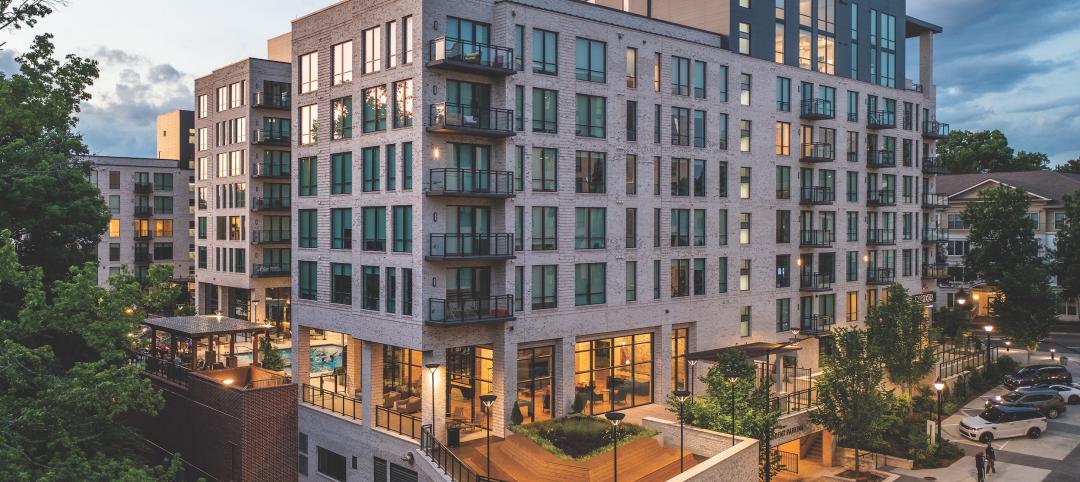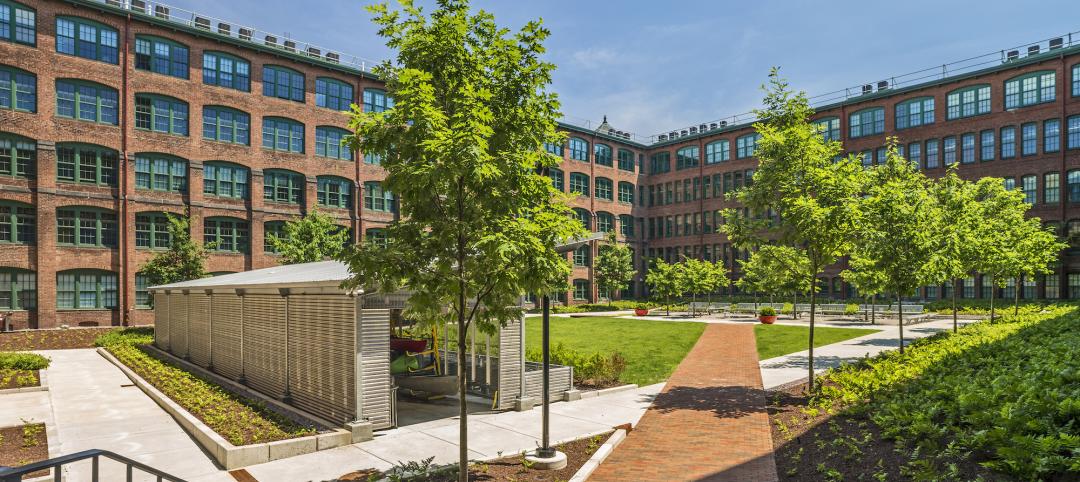Performance-based facilities for performing arts boost the bottom line
A look at design trends for “budget-wise” performing arts facilities reveals ways in which well-planned and well-built facilities help performers and audiences get the most out of the arts.
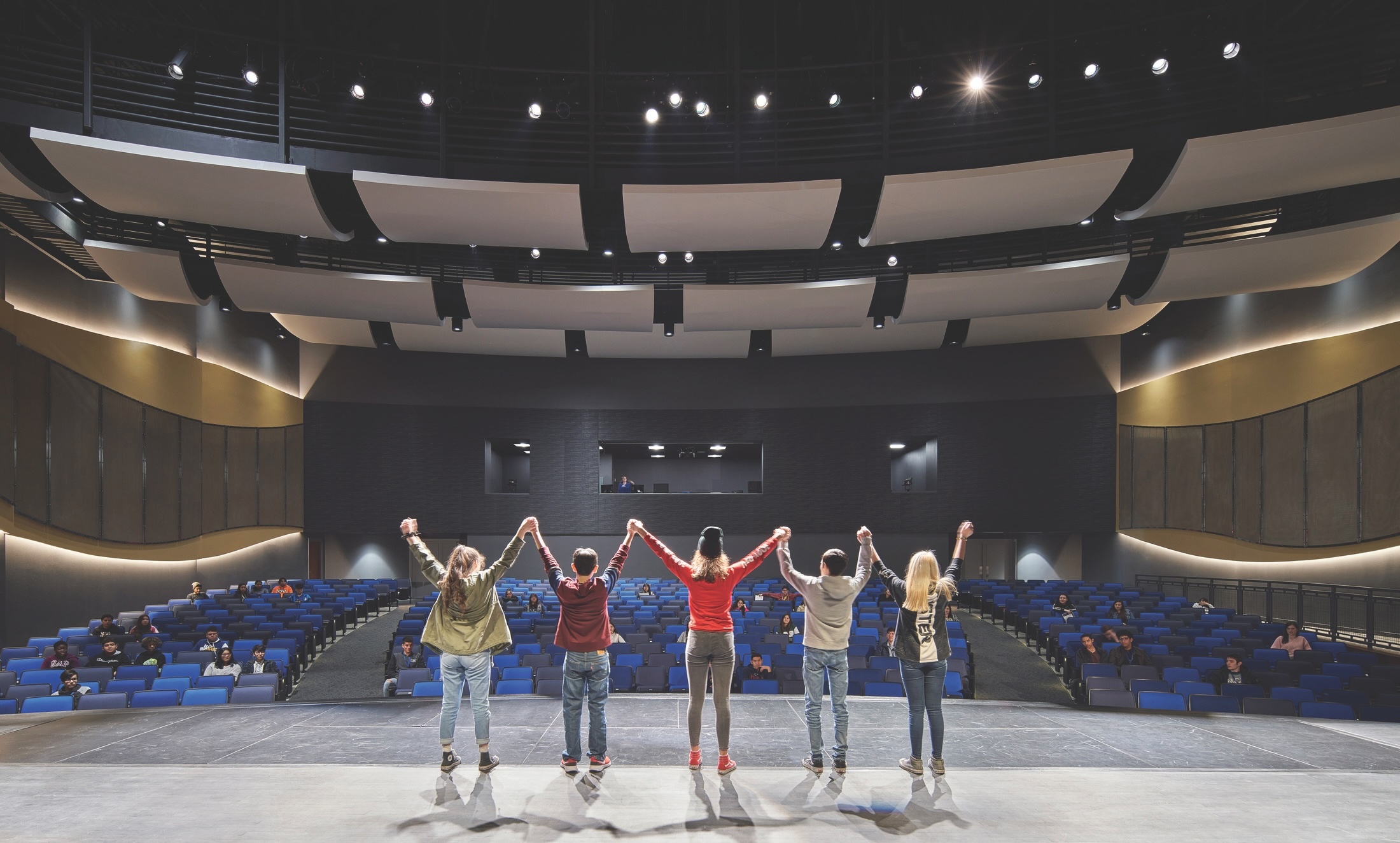
New technologies, innovations, and tools are opening doors for building teams interested in better and yet less-expensive performing arts facilities. A look at design trends for “budget-wise” performing arts facilities reveals ways in which well-planned and well-built facilities help performers and audiences get the most out of the arts.
“A growing number of K-12 school districts, small-sized higher ed institutions, and small- and mid-sized communities are stepping up their game when it comes to performing arts facilities—with more well-appointed dedicated or multipurpose theaters,” says Carmi Bee, FAIA, President of RKTB Architects, which just finished the community venue Sam’s Stage in Massachusetts, as well as multifunction auditoriums for various New York City schools. “The key is to dream big and then to plan smart to make the most of a limited budget by incorporating the latest technology while fine tuning project scale, stages, circulation, and seating.”
Performing arts settings are synonymous with flexible, multipurpose, technology-dense spaces, says Tara Ogle, AIA, LEED AP, Associate Principal and Director of Architecture with Page & Turnbull, which has been working on theaters for a boarding high school in Claremont, Calif., and a Bay Area middle school, in addition to several community theaters. “Schools are looking to leverage limited funds to support a range of programs as they plan for the future, so their projects are shifting from a very specific performance focus to spaces that can host a broad range of activities, often paired with symbiotic programs like recording and broadcast booths, maker spaces, and even robotics and virtual reality labs,” says Ogle. “Some go as far as providing the ability to break large spaces into smaller teaching areas, and then back together again.”
This is especially important for the K-12 market, where cost control tussles with desires for maximum flexibility and adaptability, often the main aim for performance spaces, says Barry Nebhut, Principal with VLK Architects. “Our first rule is, don’t put your budget in the house. Put your money and budget in the technical side, where the education happens,” he says, citing current work building four high schools around Austin, Texas, each with a performing arts center. “If that means making a smaller house, I’ll often advocate for that. Who wants to stage their dance recital with a three-quarters-empty house? Instead, perform the annual musical over a few days’ run with a smaller house.”

VLK offers a rule of thumb: For a high school, size the auditorium for a single grade level. For example, a 2,000-student high school would need a theater with 500 seats. “And don’t spend your money buying fancy seats!” Nebhut admonishes school districts.
For the auditorium design, many schools break the house into four quadrants with a raked front section, a cross aisle about the same height as the stage, a rear seating section and, in some cases, balconies. This strategy helps give the sense of a full house even when some seats are empty.
Larger high schools often build two performing arts venues: a flexible but traditional proscenium-style theater and a black-box theater, which can accommodate overflow rehearsal needs and adequate stage time for such programs as dance, music, and stagecraft.
Beyond that, many institutions and municipalities are adding outdoor facilities for both performing arts and a broad range of outdoor learning opportunities, says Page & Turnbull’s Ogle. “Where in the past we’d prioritize acoustic and daylighting control within black-box theater environments, clients today are more interested in spaces with a direct outdoor connection,” she says. “Luckily, technology is stepping up to this need, with flexible sophisticated daylighting controls and operable door and wall systems that provide the best of both worlds.”
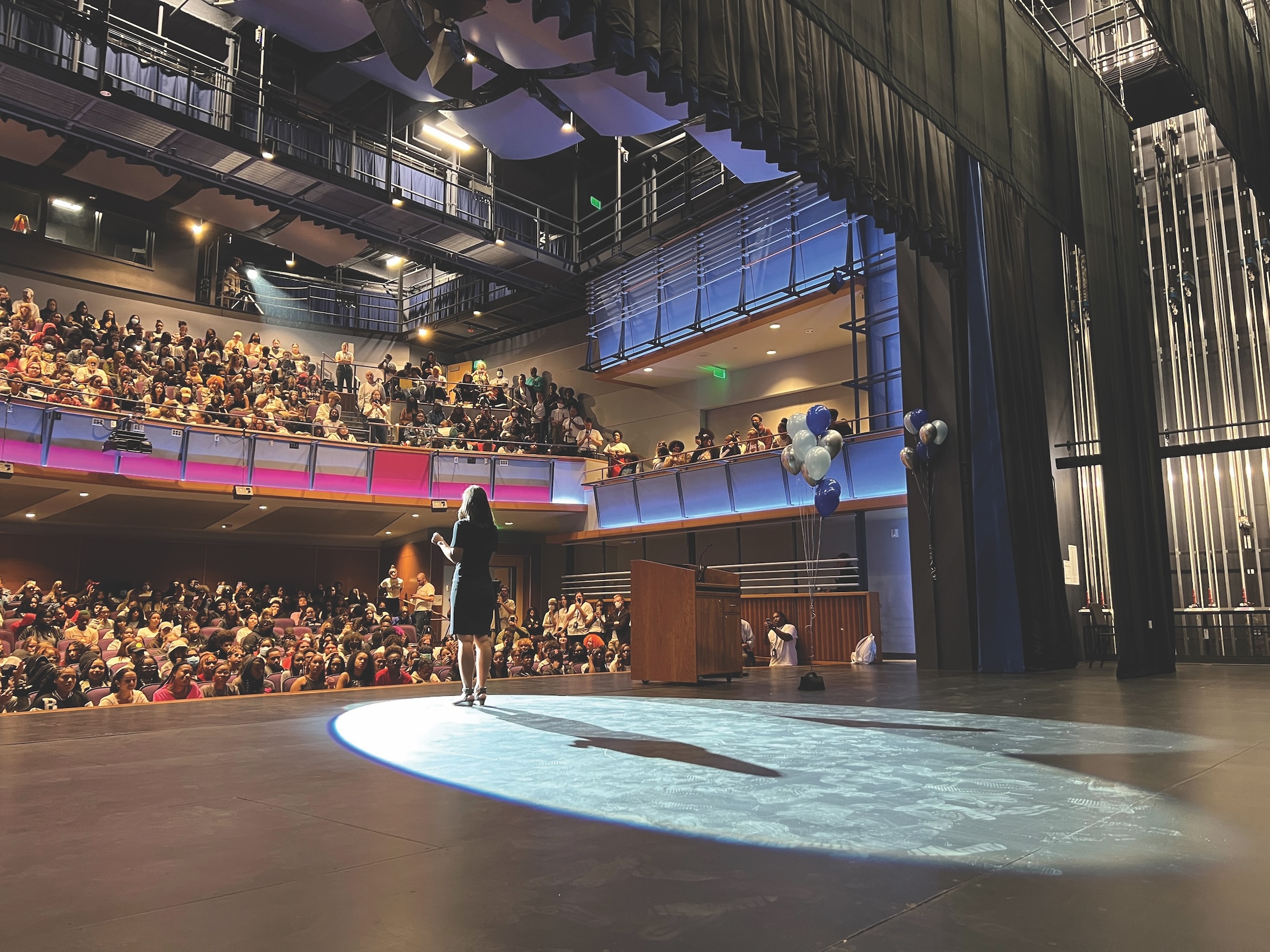
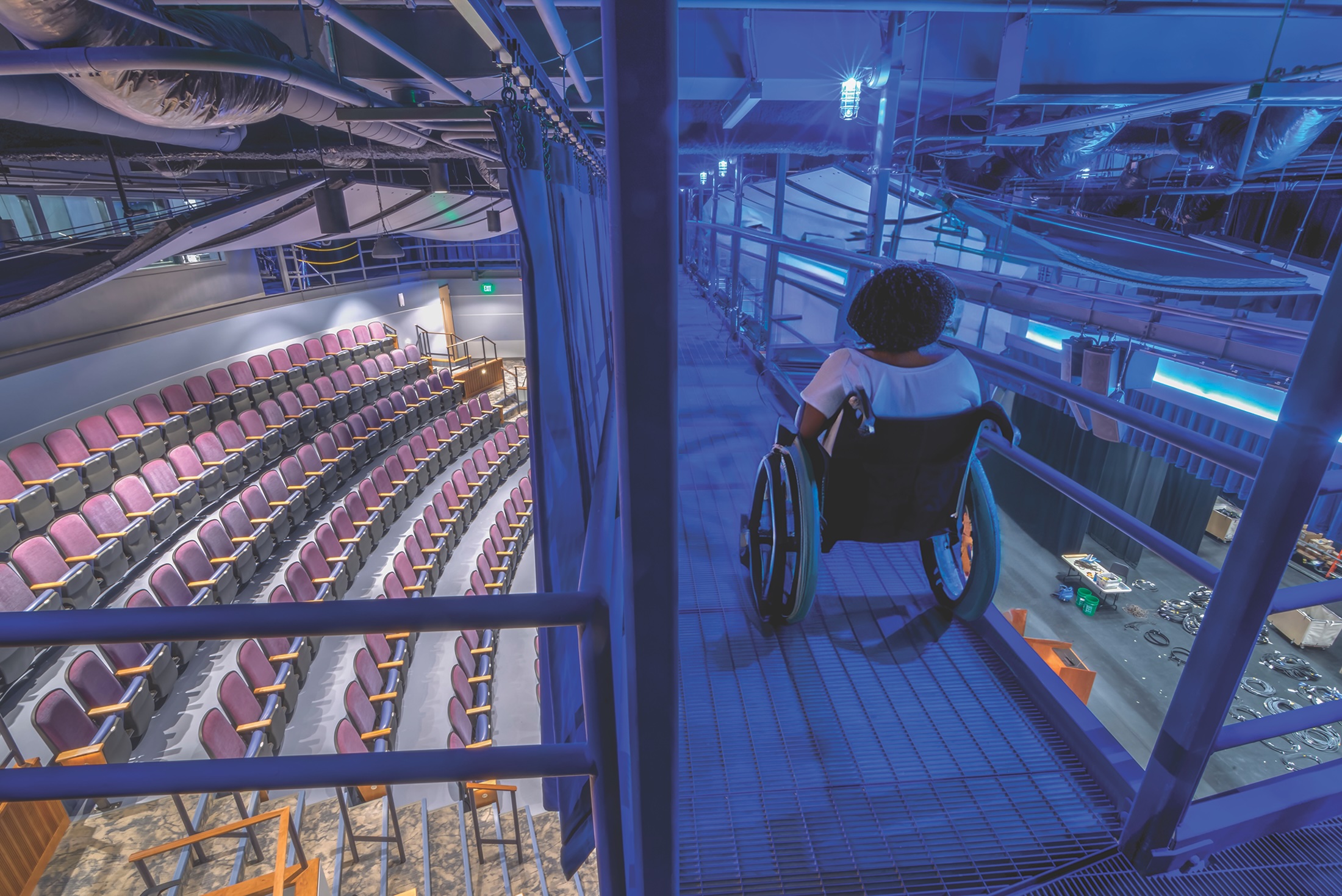
For the College of Communication & Fine Arts at Loyola Marymount University, for example, the new 22,500-sf Drollinger Family Stage is a permanent, open-air, multipurpose venue for the campus and its broader community, says Carlos Madrid III, Principal at Skidmore Owings & Merrill (SOM), which designed two performance facilities on the campus. “The project team’s directives for the last few years have been to create more multipurpose, adaptable, and flexible venues for a multiplicity of users,” he recalls. “So on top of dance, music, and theater, we suggested this outdoor stage could also support film and large-scale traveling arts while serving double duty as a café hangout—it even hosted the Los Angeles mayoral debates in 2022.”
The elegant, 24-foot-tall facility employs a grid of castellated steel ceiling beams with conduits run through its structural pipe columns. The entire roof system was shop-fabricated and shipped to the site for installation, which allowed for a high degree of precision and minimal on-site welding.
Costs and controls for performing arts facilities
Combined and multiple-user facilities are helping bring better, more advanced performing arts facilities to small-budget partners. “In conjunction with our firm’s convention center work, we’re seeing several community theaters colocate new, flexible venues along with a small- to medium-sized convention center renovation,” says TVS Principal Emery Leonard, AIA, LEED AP.
In these amalgams, says Leonard, the two institutions work together to create a larger cultural district, improving cultural placemaking rather than single, isolated uses. “These new cultural districts also work to attract mixed-use development to an area, creating a real 24/7 community,” Leonard adds, noting that TVS is currently master-planning a new arts high school colocated with a restored performing arts center.
Small community theater companies are also independently seeking cost-effective solutions for expanded programs and adaptable technology, says Andrew Franz, AIA, LEED AP, who brings a performance background to his role as Principal of Andrew Franz Architect. “We’ve studied the feasibility of a below-grade expansion for one client, a downtown theater group, resulting in a path to doubling their existing footprint and adding a new black box theater,” he says. “This kind of approach allows a simultaneous upgrade of the existing theater while creating additional rehearsal and event areas.”
For Sam’s Stage at the Truro Center for the Arts in Cape Cod, Mass., RKTB Architects designed what its client touts as a “beautiful stage able to offer an array of performances in dance, music, and poetry.” Built with “deceptively simple timber construction with integrated infrastructure for lighting and amplification, as well as an acoustically supportive roof,” the dance-oriented facility employs a sprung floor for the safety and comfort of performers. According to RKTB’s Bee, in addition to floating dance floor construction, some venues employ a portable sprung-floor panel system made with pre-built panelized sections.
Alternative stage systems can help stretch a budget, but the first step is to rightsize the venue and ensure the scale and functionality are appropriate to (a) programmatic need and (b) funding available, says A. Scott Butler, AIA, Founding Director of Wilson Butler Architects, which specializes in the arts and entertainment sectors. “The building team may find that finishes, both exterior and interior, might be a very small slice of the total pie, perhaps around 5%,” he says. “So you won’t reduce your budget by value engineering finishes—you have to reduce the size of the pie, and hold that line from schematics through CDs.”
Put another way, says Butler, “For a project that would cost $1,000 per square foot, you won’t suddenly find an alternative design for $800 per foot, so work with higher education institutions and project leaders to set realistic expectations: What does the school really need, realistically—with input from cost consultants, acousticians, and others—to deliver on their programs?” Then the team literally creates that pie chart, including not just brick-and-mortar budgets but also soft costs for consultants and engineers, and carefully estimates all construction elements including exterior shell, glazing systems, site work, interior finishes, MEP systems, and specialized theater equipment.
Adding to the equation is time and scheduling, says Tallal Bhutta, Founder and CEO of BDB Construction, which has experience in adapting commercial structures for use by universities, congregations, and community groups. “The goal is to exceed the owner’s expectations related to budget and schedule by means of a highly integrated approach to project delivery, which ensures high-quality results in a faster and tightly controlled process,” he says. “The construction firm should be involved in the earliest project phases, from predevelopment to schematics, and a partner from conception to completion.” This includes best practices in project management and coordination, supporting Bhutta’s recommendation of a “consultative role where the general contractor helps review design decisions for timetable impacts, constructability issues, and possible cost reductions.” For renovations or conversions of spaces, teams must better predict unforeseen conditions, and quickly address changes—especially creep—in work scope.
Page & Turnbull’s Ogle agrees, adding: “Plan for supply chain delays. This is a tricky one within an academic environment, where we’re often trying to fit construction in over the summer.” Also, she says, find the right partners who understand the project particulars and “are ready to jump in and actively solve problems as the environment changes.”
Keeping the design simple helps immensely, adds Butler, who also works on entertainment venues for cruise ships. “Rightsize the stage and venue to make the pie smaller and suitable to the typical users,” he says. “On ships, they can’t have very big crews, so we specify automatic rigging instead of manual rigging and lifts instead of platforms, as well as moving reflectors and motorized lighting, which are state-of-the-art systems now moving into many land-based projects.” All of them reduce maintenance needs, similar to the wide use of LED lighting, which requires fewer changes and lamp replacements as compared to older systems.
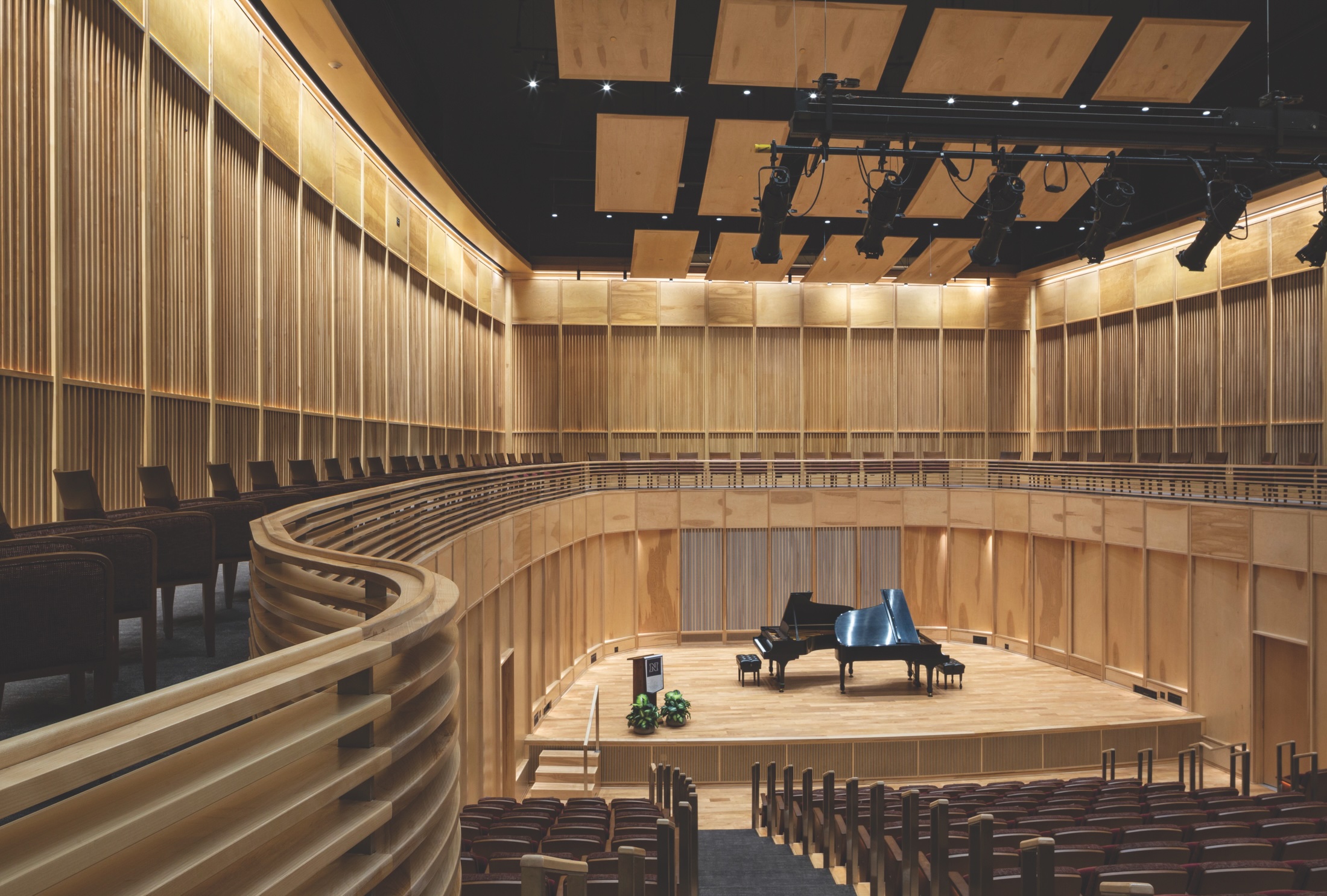
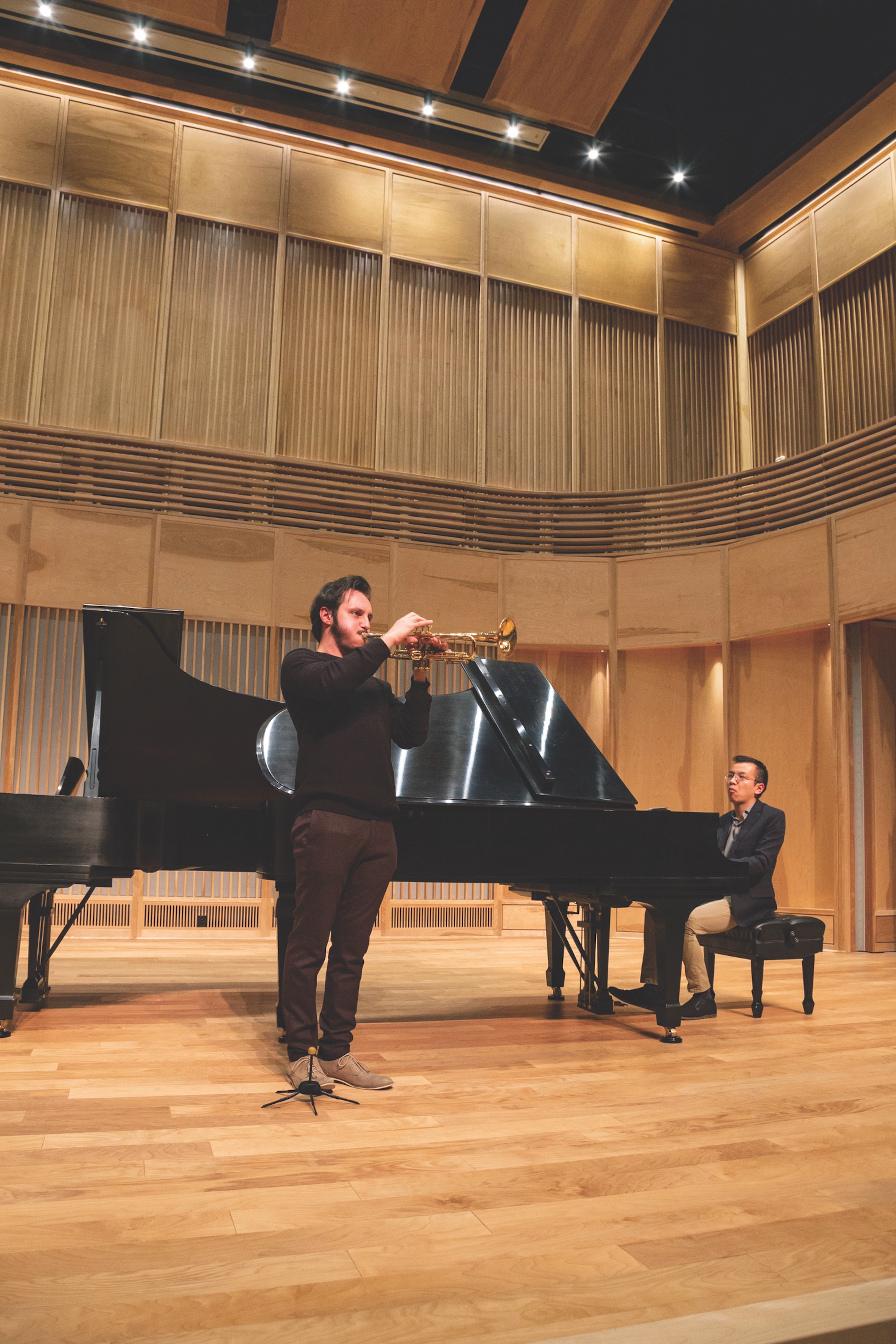
“Technology has been exploding with LED lighting and also sound systems today,” says VLK’s Nebhut. “It’s not going down in cost, but greatly increasing capabilities for what systems can do even at a K-12 or community theater level.” He adds that theatrical control systems are also advancing radically, with huge soundboards now giving way to iPad controllers and sound reinforcement systems with multiple setups for dance, music, and theater. “Put your money into those systems now, first,” he advises. “Each one is a learning opportunity for students, too, with future career application in the real world.”
Sound Choices for performing arts facilities
Architectural and theatrical systems are also offering new ways to plan and execute on another elemental design variable: acoustics. Savvy building teams begin planning for venue acoustics in the earliest phases, beginning with in site selection and options for adjacent occupancies. “Understanding adjacencies around noise-sensitive spaces is a must in a blocking-and-stacking program to minimize extraordinary construction, mitigate noise transmission, and provide the best opportunity for clarity in speech,” says Raymond Kent, ASTC, Assoc. AIA, Principal and Senior Design Leader with DLR Group.
To allow for acoustic isolation between spaces, Rebecca Krull Kraling, AIA, LEED AP, Planning Principal with HGA, offers a few options for performing arts facilities:
- Use increasingly robust wall systems and structural separations.
- Plan the facilities with buffers between spaces (reducing the need for extensive wall and structural isolation measures).
- Surround performance venues with circulation, creating a buffer between it and adjacent spaces.
Kraling used the third technique for the Huss Center, a new performing arts home on Saint Paul Academy and Summit School’s campus in St. Paul, Minn. Another tactic used for a new dance and theater building at Macalester College, also in St. Paul, Minn., made ancillary spaces into buffer zones: “For example,” she says, “if a facility needs two rehearsal rooms and each one requires storage, locate the storage between the rehearsal spaces as opposed to putting the rooms directly adjacent to one another, making the rooms’ construction less costly.”
Acoustics for multiple-use venues adds additional complexity, says Frank Reder, Associate Principal and U.S. Acoustics Discipline Lead with Buro Happold, who has worked on such world-class venues as the Obama Presidential Center and the Sphere in Las Vegas, along with much more modest facilities. “For today’s multiple-use performing arts spaces, acoustical planning can get very complex, and our goal is to create the very best solution for all anticipated uses,” he says. Advocating for diversity and expanded audiences, RKTB’s Bee points to his firm’s work on a multi-use center for the Village of South Orange, N.J., which commissioned a community performing arts center boasting a 425-seat, state-of-the-art auditorium, but also five first-run movie theaters and a multipurpose community space, all serving multiple performance types.
Even for classrooms doing double-duty as band and choral rehearsal spaces—or for multiuse, hybrid spaces such as cafetoriums, gymnatoriums, and even cafegymatoriums—it’s the same goal, adds Jonah Sacks, Director of Architectural Acoustics with Acentech: “The team needs to ask, What’s needed to achieve great acoustics for every use?” Among the factors to study are spatial volume—especially height—as well as the smart placement of “acoustic reflectors, variable acoustic absorption, and flexible furniture,” explains HGA’s Kraling.
The process involves the full building team, engaged in a review of proposed buildings, spatial volumes, support spaces, and acoustical elements, says Brandon Ross, AIA, LEED AP, Managing Partner for Texas with PBK. “Working with subject matter experts to ensure the facility’s volumes, geometry, systems, and adjacencies are reviewed in detail and optimized from the very beginning of the design process eliminates unnecessary redesigns or other schedule delays,” he says. “Meeting with acousticians early and maintaining close communication throughout keeps everyone on the same page and ensures the process runs smoothly.”
Adding to that, increased remote attendance impacts design choices, says Nicole Cuff, Principal for Acoustics with Acentech. “Facilities need to provide an excellent experience for users enjoying a performance live, as well as users (not in the space) enjoying the experience remotely,” she explains. “Facility users need to record and livestream performances, connect with remote participants, and broadcast recorded audio to performance spaces, throughout all market types.”
For the local crowd, says the architect Butler, bring the orchestra out into the auditorium space with a pit or thrust stage, so sound doesn’t get lost into the stage house. He points to examples such as Wilson Butler’s multipurpose hall for Auburn University in Alabama, which employs relatively conventional systems and works for music with tunable acoustics, which can change the reverberation time of a room.
“People are just getting smarter about acoustics; they expect better, and project teams are answering to higher aspirations from their clients and audiences,” says Buro Happold’s Reder. “The acoustics team being involved throughout, from the very first project planning meeting, is so important to helping avoid downstream adjustments and to integrating solid principles for comprehensive and positive acoustical outcomes that really enhance sustainability and wellness.”
Step Right Up, Sit Right Down
Accessibility is another point for high-quality venues, not just the front of house and seating areas, but for all new facilities, says DLR Group’s Kent. “Accessibility and universal design must reach beyond the audience and be inclusive of performers, technicians, and designers,” he says. “For example, automated rigging systems can be designed to be operated by people with limited mobility. Control booths and front-of-house mix positions should also be accessible.”
Wilson Butler’s design for the Boston Arts Academy highlights the accessibility achievable today. The school’s 500-seat proscenium theater delivers a flexible teaching and presentation venue for students in grades nine through 12, many of them pursuing careers in the visual and performing arts.
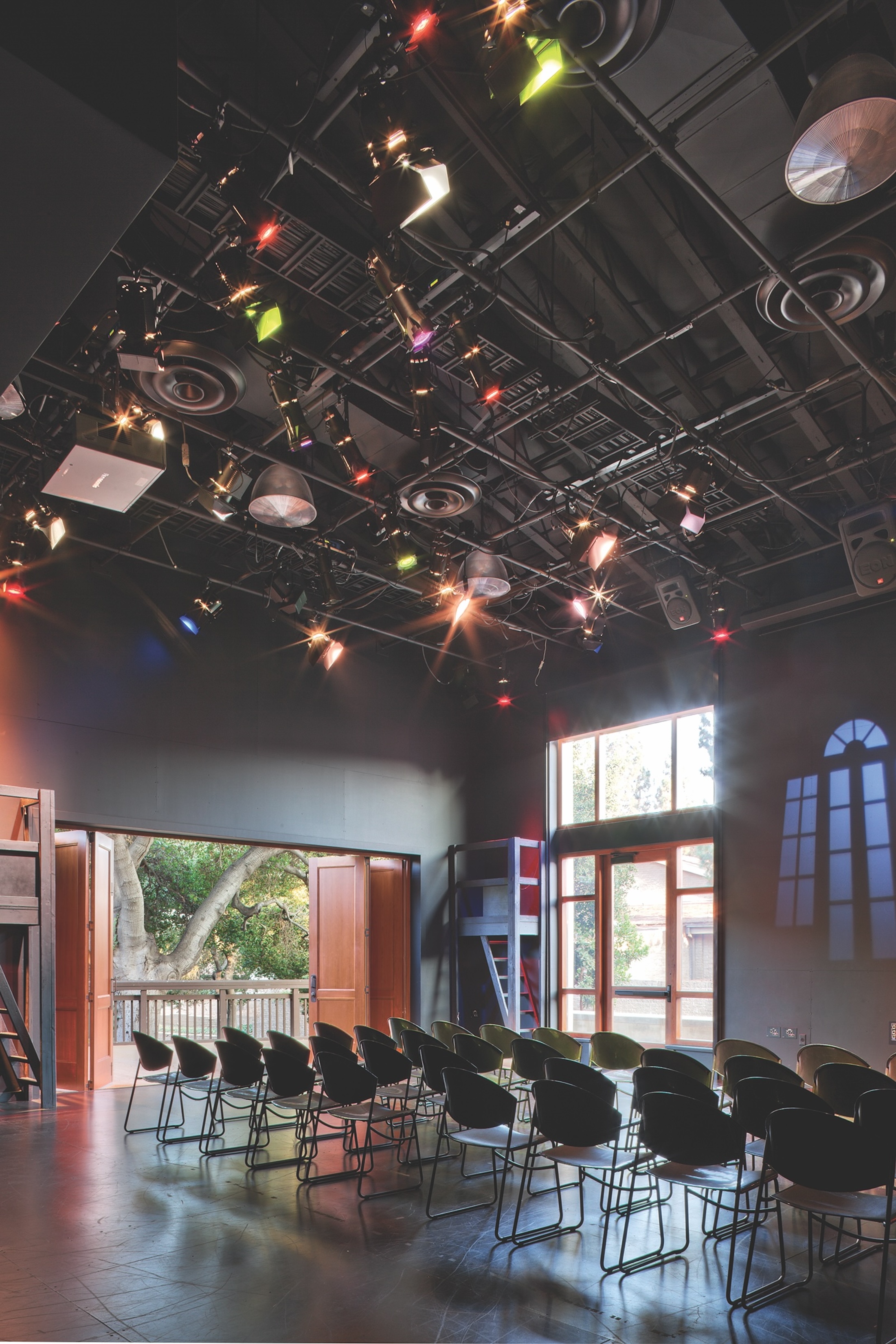
Each year, they gain first-hand experience in theater operations, from stage rigging to audio and lighting systems. Central to the design, says Butler, are “fully accessible catwalks and technical areas that expand learning opportunities for all students.”
SOM’s Carlos Madrid emphasizes the universality and access afforded by “flat-floor/black box theaters, a typology providing a very clean, universal envelope with seating such as collapsible tiered metal seating and varied setups from cabaret or runway to conventional theater to a theater-in-the-round.”
Seating options for such flexible-use performance spaces should be considered carefully, says HGA’s Kraling, asking, “Is it a ‘flat-floor’ space that will be used for rehearsal in an open-floor configuration and also a space that needs to seat an audience, which requires platforms and risers to create proper sightlines to the performance happening in the space?” If so, two general options afford this kind of flexibility: a retractable unit where one can pull risers—and sometimes seating as well—out of a wall pocket, or building risers via portable and configurable platforming systems.
Savvy building teams know retractable systems may have a higher first cost, though they can be operationally easier to manage if labor for building seating platforms is unavailable. The latter platforming types offer significantly lower first costs and much more flexibility for how the room can be configured, but also demand more space for storage—and more people-power to install, says Kraling. “We have this debate on just about every project, and each institution comes to their own decision based on priorities.”
TVS’s Leonard adds that flat-floor, telescoping bleachers are a classic solution for flexibility. Page & Turnbull’s Ogle adds: “Flexible benching/seating options that can be configured for everything from a traditional performance to robotics competitions.”
Leonard says that today’s trending “immersive” shows want the audience closer to feel like a part of the show, which demands exceptional flexibility for the event and experience creativity implied. “We’re seeing how architecture is one of the creative tools to help the performance, like at The Sphere [in Las Vegas], which wears its performance on the outside with customized AV, or the Lindemann Center at the Brown Arts Institute [in Providence, R.I.], where gantries are used to change the geometry of the hall itself,” Leonard says.
For varied performance venues, says Page & Turnbull’s Ogle: “Underfloor HVAC systems can improve acoustics and maximize flexibility overhead.” She adds that while the desire for increased visual and physical connection to the outdoors poses significant challenges from an acoustic and lighting perspective, varied solutions are possible. “The first thing our acoustic consultants recommend is balancing hard and soft surfaces to control reverberation,” says Ogle. “A wall of glass can be very challenging. Luckily there are some truly beautiful solutions that can be deployed when needed and allow for all of the openness that our clients want.”
Plan for Operations: performing arts facilities
For project planning, savvy building teams visualize future expectations and operations. “For schools, put your emphasis on learning opportunities: costume shops, scenery shops, props storage, all those are really important, so don’t compromise in the planning phase,” says VLK’s Nebhut. “You can always add acoustical curtains and clouds later, but you need catwalks and rigging right up front. Even an orchestra pit—if it’s not in the project design from the beginning, you’ll never get it later.”
The types of shows and uses expected will drive decisions, too, says Wilson Butler’s Butler. “For a successful multipurpose space, know the loading-in and -out of the hall: This affects how much crew is required for a show,” he says. “We try to be highly cognizant of how well a back-of-house design works, and how backstage can be managed and operated.” Multipurpose halls, for example, often referred to as roadhouses, should minimize crew calls for reconfiguring the room, which is costly, but also allow for maximizing seating capacity whether for music performances or Broadway shows or pop acts.
Replicating a Broadway performance environment in a typical high school may seem extravagant, yet it’s a positive direction for the future of performing arts, says PBK’s Ross. “Schools want to create facilities that accurately represent what students would see in the industry, should they choose to pursue a career in performing arts,” he notes, pointing to the firm’s recent 1,500-seat, multi-tiered facility for Cypress-Fairbanks (Texas) Independent School District’s new Visual and Performing Arts Center. “Preparing students for the professional world means recreating that world as much as possible.”
For many client groups, however, the mission of funding arts can clash with building team goals, says DLR Group’s Kent. “A trend that continues is one where the organizations are looking to maximize the value of the performing arts facilities with ever-shrinking budgets and competing interests across what are seen as more valuable tracts for the community’s benefit,” he says. “For example, premiums in K-12 or a community college may allocate dollars more in line with STEM disciplines than arts education funding.”
Performing Well: Tunable, Adjustable Space Acoustics Come of Age
Among the most inventive areas of performing arts technology developed in recent years is a new class of novel acoustic solutions for theaters, auditoriums, concert halls, and other performing arts venues. These products include portable acoustical panels, shells, motorized banners, and adjustable overhead and wall units, either hung or otherwise affixed to the interior structure. Their success among budget-conscious end-users such as K-12 schools, colleges, and community theater troupes has inspired their adoption in larger and even professional venues.
The variable panels and automated, motorized systems offer the ability to create a dynamic, tunable space ideal for venues with less staff or varied programmatic needs, or both. With tunable acoustics, end-users can change the reverberation time of a room, for example, or adjust the reflective and diffusion qualities of performance spaces and surfaces.
“These performance spaces should direct sound from the stage to the audience volume, and the adjustable banners and curtains can be used to deaden the room, for example, for amplified music,” says A. Scott Butler, AIA, Founding Director of Wilson Butler Architects. “The orchestra shell is something we can customize, so it has finishes that match the rest of the hall. We also use overhead reflectors that get flown up into the fly tower, as well as acoustic battens.”
According to Mark Holden, Principal of Acoustics for the acoustic and audiovisual design firm Jaffe Holden (which helped pioneer and design a number of adjustable acoustic systems), double-layer fabric banners are effective for absorbing sound and tuning a room to enhance a wide range of performances. “The acoustics of a room are excellent only for a specific program on the stage, which can range from orchestra and band to amplified Broadway shows,” says Holden. “Getting these professional-level systems into high schools is rather extraordinary, and we’re seeing Texas leading the way in high school acoustic systems.”
Adds Buro Happold’s Frank Reder, Associate Principal and U.S. Acoustics Discipline Lead, “Building teams should look into these portable and adjustable acoustical products, such as panels, sheets, motorized banners, and adjustable panels, as well as ceiling panels and clouds and wall-mounted acoustic products. They offer immediate and long-term benefits.”
Portable acoustical panels and motorized acoustic banners are invaluable, especially for budget-conscious projects that need to serve multiple functions, adds Nicole Cuff, PE, LEED AP BD+C, Principal Acoustical Consultant and K-12 Education Market Leader with Acentech. “With adjustable absorption, one space may be used for performance, rehearsal, and lectures more easily than a room with fixed finishes,” she explains. “Facility users tend to prioritize one particular type of performing art and often do not have the budget for another dedicated room to support another specialty.”
Holden stresses this benefit: “To be able to tune theaters acoustically allows the rooms to be used for a multiplicity of functionality,” he says. “The motorized acoustic banners are on the side walls and within the ceiling area. On stage, you’ll have a moveable, tunable orchestra shell, or concert enclosure, which has ceiling clouds and movable walls that create a concert hall-like environment within the stage.
“It’s a very sophisticated set of equipment,” concludes Holden.
More Campus Related Content
Structural
Waterproofing deep foundations for new construction
Below-grade waterproofing systems can be critical features of building enclosure design, particularly when the structure has a deep foundation. As…
 course credit: 1.0 AIA LU/HSW
course credit: 1.0 AIA LU/HSW
Exterior
For the Multifamily Sector, Product Innovations Boost Design and Construction Success
It seems fitting that wider adoption of thin-shell concrete, a technology popular worldwide but somehow unfavored in the U.S., has resulted from the…
 course credit: 1.0 AIA LU/HSW
course credit: 1.0 AIA LU/HSW
Provided By: BD+C
Exterior
Fire safety considerations for cantilevered buildings [AIA course]
Cantilevered buildings seem to be everywhere in New York City these days, as developers and architects strive to maximize space, views, and natural…
 course credit: 1.0 AIA LU/HSW
course credit: 1.0 AIA LU/HSW
Provided By: BD+C
Exterior
4 steps to a better building enclosure
Dividing the outside environment from the interior, the building enclosure is one of the most important parts of the structure. The enclosure not…
 course credit: 1.0 AIA LU/HSW
course credit: 1.0 AIA LU/HSW
Provided By: BD+C
With affordability and innovation for all: Multifamily housing ideas break barriers
With a growing need for multifamily housing solutions at all income levels, the U.S. market is seeing a proliferation of inventive projects.…
 course credit: 1.0 AIA LU/HSW
course credit: 1.0 AIA LU/HSW
Provided By: BD+C
Exterior
Metal cladding trends and innovations
Metal cladding is on a growth trajectory globally. This is reflected in rising demand for rainscreen cladding, which market research firm VMR values…
 course credit: 1.0 AIA LU
course credit: 1.0 AIA LU
Provided By: BD+C
Structural
Flood protection: What building owners need to know to protect their properties
Historically, flooding is one of the costliest natural disasters in the United States on an annual basis. Flood Insurance Rate Maps (FIRMs) attempt…
 course credit: 1.0 AIA LU/HSW
course credit: 1.0 AIA LU/HSW
Provided By: BD+C
Multifamily housing/Apartments/Condominiums
Urban housing revival: 3 creative multifamily housing renovations
Bruner/Cott’s AIA award-winning inaugural project, the 1974 transformation of Boston’s expiring Chickering & Sons Piano Factory into the Piano…
 course credit: 1.0 AIA LU
course credit: 1.0 AIA LU
Provided By: BD+C
Structural
Steel structures offer faster path to climate benefits
Faster delivery of buildings isn’t always associated with sustainability benefits or long-term value, but things are changing. An instructive case is…
 course credit: 1.0 AIA LU/HSW
course credit: 1.0 AIA LU/HSW
Provided By: BD+C
Moisture Solutions
Solutions for cladding performance and supply issues
From a distance, today’s building innovations in cladding performance, aesthetics, and construction appear unconstrained and quite varied. Material…





